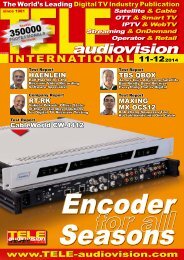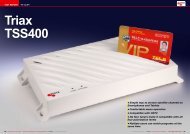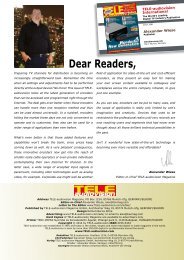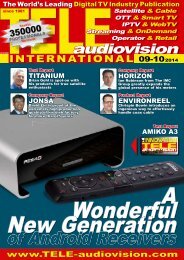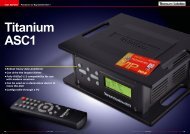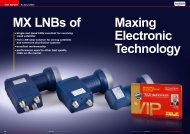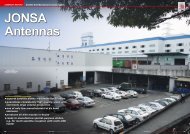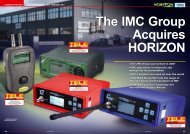of Maxing
You also want an ePaper? Increase the reach of your titles
YUMPU automatically turns print PDFs into web optimized ePapers that Google loves.
TEST REPORT<br />
One Cable LNB<br />
MX-OCS12<br />
<strong>of</strong> <strong>Maxing</strong><br />
• receives two sub bands in the Ku band<br />
and transmits them in one cable<br />
• perfect for use with existing tv cablings,<br />
replacing terrestrial tv with satellite tv<br />
• restricts the number <strong>of</strong> possible channels<br />
to the ones transmitting in the two sub<br />
bands <strong>of</strong> the Ku band<br />
• no hazzle with switching between two<br />
bands<br />
50 TELE-audiovision International — The World‘s Leading Digital TV Industry Publication — 11-12/2014 — www.TELE-audiovision.com<br />
www.TELE-audiovision.com — 11-12/2014 — TELE-audiovision International — 全 球 发 行 量 最 大 的 数 字 电 视 杂 志 51
TEST REPORT<br />
One Cable LNB<br />
What Is a One Cable LNB?<br />
The universal LNB for Ku-<br />
Band has become something<br />
so standard that many <strong>of</strong> us<br />
think that nothing else is <strong>of</strong>fered<br />
on the market. That<br />
is not true. There are other<br />
products available. And<br />
one <strong>of</strong> such non-standard<br />
LNB for Ku-Band is the MX-<br />
OCS12 <strong>of</strong> <strong>Maxing</strong>. The manufacturer<br />
calls it “one cable<br />
LNB” and this needs some<br />
explanation.<br />
The MX-OCS12 converts<br />
two specific sub bands <strong>of</strong> the<br />
lower part <strong>of</strong> the Ku-Band<br />
to the L-Band. These sub<br />
bands are: 10.7~11.2 GHz<br />
at vertical polarization and<br />
11.45~11.7 GHz at horizontal<br />
polarization. Because its<br />
local oscillator works at the<br />
typical frequency <strong>of</strong> 9.75<br />
GHz, the two sub bands are<br />
shifted into the following<br />
frequency ranges in L-Band:<br />
OCS12 LNB looks as a typical<br />
product for Ku-Band. Quality<br />
<strong>of</strong> workmanship is excellent<br />
but as we have noted before,<br />
<strong>Maxing</strong> uses lables printed<br />
on paper. Whilst this would<br />
not concern us much with<br />
any regular LNB in this case<br />
with such a special LNB it<br />
might be good to be able to<br />
read the specifications also<br />
after the LNB is exposed<br />
to the outdoor world being<br />
mounted on a dish.<br />
Of course, the type <strong>of</strong> lable<br />
on a LNB is not at all critical.<br />
What really counts is the<br />
product performance. For<br />
our TELE-audiovision test<br />
we selected the HOTBIRD on<br />
13° East as our source <strong>of</strong> signal<br />
and a modern universal<br />
LNB as our reference LNB.<br />
Our measurements revealed<br />
0.95~1.45 GHz and 1.7~1.95<br />
GHz. Now, the trick is that<br />
you can connect more than<br />
one satellite receiver to the<br />
output: if only one <strong>of</strong> the<br />
receivers supplies the MX-<br />
OCS12 LNB with d.c. voltage<br />
(in the range <strong>of</strong> 11.5~19<br />
volts) all the other receivers<br />
in the chain may have<br />
their LNB power switched<br />
<strong>of</strong>f. Now the question is:how<br />
many receivers can then<br />
be connected to that one<br />
LNB? Well, this depends on<br />
the sockets you will use.<br />
The sockets have splitters<br />
that may differ in insertion<br />
and tap losses. With typical<br />
sockets, you should be able<br />
to connect 8~10 receivers to<br />
the output <strong>of</strong> the MX-OCS12<br />
LNB and all <strong>of</strong> them wil be<br />
able to tune into the above<br />
mentioned two sub bands.<br />
From the outset the MXthat<br />
the MX-OCS12 LNB performed<br />
very well in its vertical<br />
sub band (10.7~11.2<br />
GHz). It generated stronger<br />
signals than the reference<br />
LNB without compromising<br />
signal quality. MER was<br />
practically identical with the<br />
reference LNB. Moreover,<br />
it was able to work even at<br />
11.279 GHz so the vertical<br />
sub band was slightly wider<br />
than promised.<br />
Output signal for the horizontal<br />
sub band was a little<br />
bit weaker than our reference.<br />
Also signal quality was<br />
somewhat poorer. MER was<br />
by 0.5~1.5 dB lower than<br />
our reference. However,<br />
MER=12 dB still guarantees<br />
very solid reception even in<br />
terrible weather conditions.<br />
So, if the MX-OCS12 LNB is<br />
used for a similarly strong<br />
satellite as HOTBIRD then its<br />
slightly weaker performance<br />
in horizontal sub band will be<br />
unnoticeable.<br />
The MX-OCS12 LNB by<br />
<strong>Maxing</strong> is a unique solution<br />
to some special situations,<br />
mainly when only the transponders<br />
on the two sub<br />
bands, which the MX-OCS12<br />
LNB supports, need to be<br />
received. In such a case<br />
the MX-OCS12 LNB allows<br />
for a very simple chain installation,<br />
as normally used<br />
in regular terrestrial tv dis-<br />
11-12/2014<br />
MAXING MX-OCS12<br />
Perfect for using with existing tv cabling<br />
www.TELE-audiovision.com/14/11/maxing<br />
52 TELE-audiovision International — The World‘s Leading Digital TV Industry Publication — 11-12/2014 — www.TELE-audiovision.com
expert<br />
OPINION<br />
MAXING MX-OCS12<br />
One Cable LNB<br />
RECOMMENDED<br />
PRODUCT BY<br />
Jacek Pawlowski<br />
Test Center<br />
Poland<br />
tribution systems. The MX-<br />
OCS12 LNB is thus a perfect<br />
solution to replace a terrestrial<br />
antenna with a satellite<br />
dish and leaving the existing<br />
cabling intact - provided<br />
the satellite in question <strong>of</strong>fers<br />
the desired tv channels<br />
in the two sub bands. This<br />
<strong>of</strong> course depends on each<br />
users preference and each<br />
satellites channel allocation.<br />
At any rate, the MX-OCS12<br />
LNB is an elegant and easy<br />
to install option well worth to<br />
consider in such situations.<br />
+ ● Very good performance in the vertical sub band<br />
● One cable LNB simplifies distribution network as no multiswitches<br />
are needed but just sockets and a number <strong>of</strong> receivers can<br />
be connected to the same cable<br />
– ● The One cable solution limits the number <strong>of</strong> transponders that<br />
one is able to receive; you should check first if all the channels <strong>of</strong><br />
interest are indeed located within the two sub bands this LNB is able<br />
to receive<br />
■<br />
TELE-audiovision already tested the<br />
MB04, a LNB with integrated DiSEqC<br />
switch<br />
http://www.tele-audiovision.com/<br />
TELE-audiovision-1407/eng/maxing.pdf<br />
■<br />
<strong>Maxing</strong> is an innovative manufacturer <strong>of</strong><br />
LNBs. TELE-audiovision has presented<br />
other LNBs models: Single, Twin and Quad<br />
http://www.tele-audiovision.com/<br />
TELE-audiovision-1409/eng/maxing.pdf<br />
54 TELE-audiovision International — The World‘s Leading Digital TV Industry Publication — 11-12/2014 — www.TELE-audiovision.com<br />
www.TELE-audiovision.com — 11-12/2014 — TELE-audiovision International — 全 球 发 行 量 最 大 的 数 字 电 视 杂 志 55




